The MENA payments sector is continuing its accelerated growth curve sparked last year. Driven by booming ecommerce adoption and a growing fintech ecosystem, the region is seeing tailwinds in paytech and cashless trends.
According to Checkout.com’s 2021 report on ‘Digital transformation in MENA and Pakistan’, 76% of MENA consumers reported using a fintech app in the past year. This closely matches the 80% reported in the APAC region.
Ecommerce is largely responsible for this development. The ecommerce sector in the MENA region, the fastest growing across the world, is expected to reach US$49 billion next year, the report cited. Between 2020 and 2021, a total of 209 million people have shifted to online shopping.
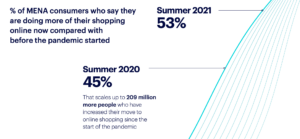
Source: Checkout.com
Overall, the MENA payments sector is largely benefitting from a region-wide ecommerce and contactless payments drive that started due to COVID-19.
BNPL’s popularity surges, while fintech funding takes a leap
Mo Ali Yusuf
“The rapid rise of fintech in the region, the heft thrown behind the digitisation of finance and the economy, and the meteoric rise of buy now, pay later (BNPL) and of social channels for shopping are all especially important highlights this year,”
Mo Ali Yusuf, Regional Manager for MENAP, Checkout.com, said in the report.
The report especially highlighted soaring interest in BNPL. These solutions are already gathering steam worldwide for providing mostly interest-free instalments. At the same time, in the MENAP region, they are especially helpful in addressing a “long standing trust deficit” for prepayment options, the report said.
BNPL market penetration was found to be the highest in Saudi Arabia (39%) and Qatar (34%).

Source: Checkout.com
Elsewhere, digital wallets are also gaining traction, so much so that the report called on MENAP merchants to work out payment strategies based on wallet acceptance.
The market for digital wallets is likely to heat up in the short term, the report said. With the financial services market becoming more competitive, financial and telecom companies are looking at digital wallets as the first step to acquiring banking licenses.
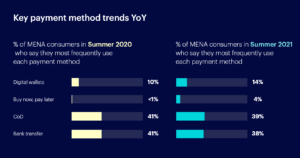
Source: Checkout.com
Meanwhile, improved fintech regulations and regulatory support, growing consumer adoption, and greater access to accelerators, were cited as factors laying the ground for fintech funding.
Highlighting the funding raised this year by baraka, Rain, BitOasis, Sarwa, Tamara (in which Checkout.com has invested), and Ziina, the report also said that an increasing number of global players are entering the MENAP payments and fintech market.
Top trends for payments in the MENAP region
Ecommerce was the top trend fuelling the MENAP payments sector, according to the Checkout.com report. This year, the use of digital commerce channels has increased at higher levels than expected. Net year on year growth has been seen across meals (+6%), household items (+4%), groceries (+9%) and even luxury goods (+3%).
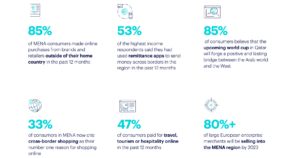
Source: Checkout.com
Secondly, cash on delivery and bank transfers have seen a YoY decrease for online payments. About two-thirds of MENA consumers prefer to make ecommerce payments digitally, including through digital wallets and BNPL apps.
Further, cross-border ecommerce and payments has seen an uptick on the consumer front. In the past 12 months, 85% of MENA consumers purchased from online brands and retailers outside their home country.

Source: Checkout.com
Amidst this thriving environment, the report also highlights challenges relating to false declines. Last year, 20% of consumers in MENA reported having suffered at least one false decline in the previous 12 months (as compared to 14% in Europe and 12% in the APAC region). This year, the self reported false declines rose by 2%.
In this context, solutions such as 3D Secure 2.0 helps to bring automation and accuracy to the authentication process. Other solutions, such as one-time passwords, biometric authentication, and mobile app QR codes, can also add a layer of frictionless authentication, the report suggested.
Featured image credit: Checkout.com



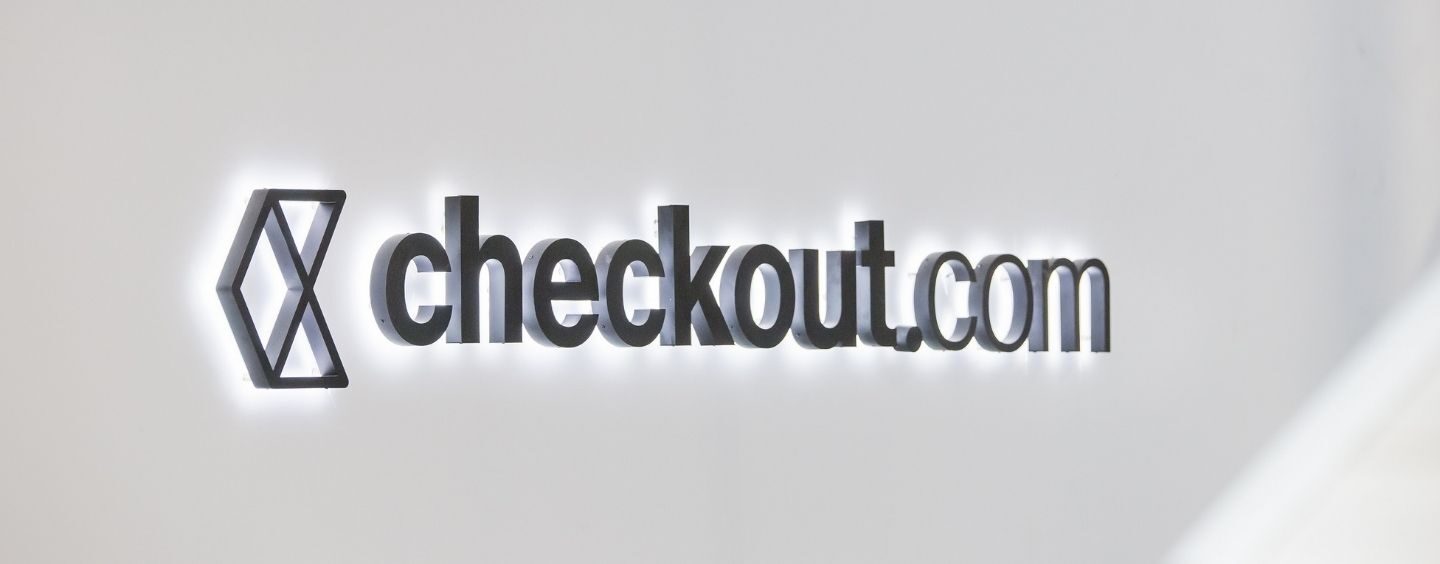


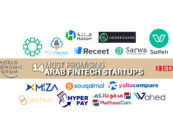


2 Comments so far
Jump into a conversation